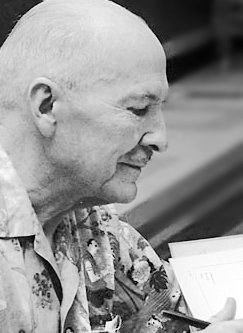Robert Heinlein left behind a body of work with a bewildering diversity of imaginings and ideas. It would be difficult to reconcile the free love, communal interests of the novel Stranger in a Strange Land, with say, the martial authoritarianism of Starship Troopers, or the anarchic libertarianism of The Moon Is a Harsh Mistress. Indeed, doing so would be impossible. And there is little doubt this has much to do with why his readers appreciate his writing so much.
 Robert Heinlein was born in 1907 in Missouri, and he grew up with six siblings in Kansas where money was tight. In young adulthood, he joined the Navy, but was forced to retire in 1934 following a debilitating bout of tuberculosis.
Robert Heinlein was born in 1907 in Missouri, and he grew up with six siblings in Kansas where money was tight. In young adulthood, he joined the Navy, but was forced to retire in 1934 following a debilitating bout of tuberculosis.
Thanks to help from his disability pension, Heinlein had the freedom to dip into a variety of occupations. He invested in silver mines, sold real estate, tried architecture, took graduate courses, and wrote.
Heinlein took to writing professionally in middle age in part to pay the mortgage. A man with a strong imagination inclined to extrapolate, he would sell science fiction stories to pulp magazines (he was a master of “if this was true, what else would be true?” and taking it to its logical conclusion). His wife Leslyn helped him craft his fiction, and he made his debut in 1939, with the story “Life-Line” in the publication Astounding Science-Fiction.
Heinlein and Leslyn lived a liberal, bohemian life. They backed up their belief in free love by conducting an open marriage, even creating for a time a triple arrangement with Scientology founder L. Ron Hubbard. Political activism included support for End Poverty in California, an organization meant to push the Democratic Party more to the left.
His leftist affiliations barred him from entry to the Navy come WWII. They wanted nothing to do with Heinlein or his beliefs, though the armed forces were deprived of personnel all across the board. Heinlein did extend his technical and scientific expertise working as an engineer in Philadelphia, where in 1944 he helped design a high-altitude pressure suit, an ancestor of the spacesuit.
At the time he also met and developed a crush on Lt. Virginia "Ginny" Gerstenfeld. After the war, both Heinlein and Gerstenfeld were living in California, and following Heinlein's split from Leslyn, the two were married. Heinlein would undergo a political and ideological transformation that would lead to the height of his career.
It surely helped that he moved from the liberal Leslyn to the conservative Ginny, but Heinlein’s political shift was immensely personal. He exorcised his radical, free-loving, counter-cultural, communal politics with the 1961 novel, Stranger in a Strange Land, coming on the heels of the militaristic Starship Troopers two years earlier. His novel became immensely popular with hippies and science fiction fans, and resonated in a restless cultural time when people took to imagining different and perhaps progressive worlds.
Of course Heinlein, being in the business of creating new worlds, could never avoid being political. He grew up on the intoxications of H.G. Wells’ novels, and early on it seemed to him scientific progress and political progress—in Wells this was socialism—went hand in hand. With age, Heinlein moved toward a right-wing libertarianism, though he wrote to his brother in 1964 that “From my point of view what has happened is not that I have moved to the right; it seems to me that both parties have moved steadily to the left.”
Heinlein apparently became more interested in self-sufficiency, smaller government, independence, and flirted in his novels with a kind individualistic anarchy. The Moon Is a Harsh Mistress concerns a lunar colony seeking independence from the Authority, a totalitarian state back on Earth. Inhabitants prefer a free currency and market, gravitating toward the self-reliant “rational anarchism” as described by a character in the novel.
As Stranger in a Strange Land popularized the verb “to grok,” describing a communal, drinking and sympathetic union, The Moon Is a Harsh Mistress made popular the phrase “there ain’t no such thing as a free lunch,” initialized as TANSTAAFL in the novel. He later earned the praise of Milton Friedman and himself gave tribute to the ideas of Ayn Rand and small government. It signified a departure from the man who for much of his life supported space travel and colonization, a big government program for sure; surely estranged, too, from the pension-collecting Heinlein who wrote in 1941 that “This country has been very good to me, and the taxpayers have supported me for many years.”
Heinlein’s politics, however contentious or complicated at times, are crucial to the liveliness of his work, but they are not themselves the entirety of it. He was a master of plot, of imagination, of bringing his readers in. This engagement, lively and joyful and inventive, lives above the arguments.










